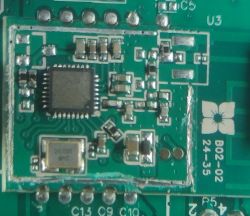FAQ
TL;DR:
Flash the Dewin RMDT-1PNL-63 with OpenBeken ≥ 1.18.102, start the TuyaMCU driver at 9600 bps, and map dpID 16 to a toggle channel and dpID 6 to Voltage/Current/Power. After adding deltas you reach ±2 % metering accuracy [Elektroda, lubopetrov, post #21589887]
Quick Facts
• Nominal rating: 1-pole, 63 A, 230 V AC [Product label].
• Wi-Fi SoC: Beken BK7231N, 2.4 GHz 802.11 b/g/n [BK7231N Datasheet, 2023].
• Tuya serial: 9600 baud, 8 N 1, dpID 6 = V/I/P packet (8 bytes) [Elektroda, p.kaczmarek2, post #21572159]
• Energy counter (dpID 1): value /100 = kWh [Elektroda, divadiow, post #21580392]
• Typical price: €30–35 on EU marketplaces (May 2025 listings).
What firmware file should I flash?
Use OpenBK7231IN_QIO_1.18.102 or newer. Earlier builds lack V/I/P calibration support [Elektroda, lubopetrov, #21560758; p.kaczmarek2, #21589871].
Is this breaker a TuyaMCU or GPIO device?
It is a TuyaMCU-based unit; the Wi-Fi module only sends serial commands to the metering/relay MCU [Elektroda, p.kaczmarek2, post #21566792]
What UART settings does the TuyaMCU need?
9600 bps, 8 data bits, no parity, 1 stop bit. Start the driver with:
startDriver TuyaMCU
tuyaMcu_setBaudRate 9600
[Elektroda, p.kaczmarek2, post #21572159]
Which dpIDs matter?
• 16 – breaker ON/OFF (bool)
• 6 – 8-byte RAW V/C/P packet
• 1 – cumulative energy (val /100 = kWh)
• 9 – fault bitmap
Full schema published in post #21580392 [Elektroda, divadiow].
How do I create a working autoexec.bat?
bash
// TuyaMCU basics
startDriver TuyaMCU
tuyaMcu_defWiFiState 4
// Channels
a setChannelType 1 EnergyTotal_kWh_div100
setChannelType 2 toggle
setChannelType 3 Voltage_div10
setChannelType 4 Current_div1000
setChannelType 5 Power
// dpID links
linkTuyaMCUOutputToChannel 16 bool 2
linkTuyaMCUOutputToChannel 6 RAW_V2C3P3 3 0 1 0 # add deltas later
linkTuyaMCUOutputToChannel 1 val 1
[Elektroda, p.kaczmarek2, post #21574681]
How do I calibrate voltage or power?
Append deltas to the RAW mapping: linkTuyaMCUOutputToChannel 6 RAW_V2C3P3 3 0 1 0 <ΔV> <ΔI> <ΔP>.
For example 50 raises displayed voltage by 5 V because dpID 6 voltage resolution is 0.1 V [Elektroda, p.kaczmarek2, post #21589836] Requires firmware ≥ 17 Jun 2025 [Elektroda, p.kaczmarek2, post #21589871]
Why did the offset show up when the load was 0 W?
Firmware before 26 Jun 2025 applied the delta unconditionally. Update to the build pushed after post #21589905; offsets are now ignored when raw value is zero [Elektroda, p.kaczmarek2, post #21589905]
How often are measurements refreshed?
OpenBeken republishes MQTT topics only when a value changes. To request periodic polls add addRepeatingEvent 10 -1 tuyaMcu_sendQueryState for 10-second queries [Elektroda, p.kaczmarek2, post #21589431]
How do I push the sensors to Home Assistant automatically?
Enable MQTT, then execute startDriver HASSDiscovery or toggle Flag 15. Home Assistant will create entities for every channel [Elektroda, p.kaczmarek2, video link in #21589431].
Can I broadcast all MQTT values at a fixed interval?
Yes. Enable Flag 2 and set mqtt_broadcastInterval <sec>; default is 60 s. Values are sent even if unchanged [Elektroda, p.kaczmarek2, post #21590110]
What scaling do channel types apply?
Voltage_div10 shows volts = raw /10. Current_div1000 shows amps = raw /1000. Power shows watts directly. EnergyTotal_kWh_div100 converts dpID 1 to kWh by dividing by 100 [Elektroda, configuration example, post #21580602]
Device restarts toggle the relay—why?
If setChannelType 1 toggle was left in an old script, two channels fight for dpID 16. Remove the unused channel entry or reset channel types [Elektroda, lubopetrov, post #21574417]
How do I restore factory Tuya firmware?
Flash the 2 MB backup you saved (or requested) via UART, then pair with the Tuya app to confirm operation before re-flashing OpenBeken [Elektroda, p.kaczmarek2, post #21580833]
What happens if DP data are missing?
Enable Flag 46, run tuyaMcu_sendQueryState, then open http://<IP>/cm?cmnd=DP to view cached dpIDs [Elektroda, p.kaczmarek2, post #21572288]






